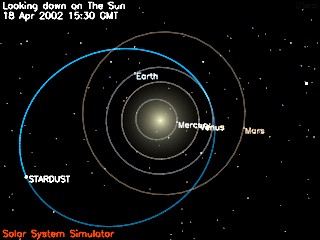Stardust Sets New Distance Record

Apr 18, 2002 - Since its launch on February 7, 1999, the Stardust spacecraft has traveled over two billion kilometers completing one and a half elliptical orbits around the Sun. On Thursday, April 18th, the mission will reach a major milestone when it arrives at its furthest distance from the Sun, also known as its aphelion.
At this time the spacecraft will be 2.72 Astronomical Units (407 million kilometers or 253 million miles) from the Sun, and near the middle of the asteroid belt. This is the farthest distance ever reached by a solar-powered spacecraft. Far beyond the orbit of Mars, the sunlight intensity is only 13% of what we see at Earth resulting in very cold temperatures and diminished power generation by the spacecraft's solar cells. The spacecraft is performing excellently in this environment and operations teams at the Jet Propulsion Laboratory, California and Lockheed Martin Astronautics, Denver are eager to enter the final phases of the mission.
After aphelion, Stardust will begin falling back towards the Sun and by the end of the mission, in January 2006, it will have completed another loop and a half around the Sun. On January 2, 2004, on its final solar orbit, Stardust will fly past comet Wild 2 to collect samples and return them to Earth in 2006. In January 2006, the samples will be delivered by parachute inside the Stardust Sample Return Capsule to the Utah Testing and Training Range.
The comet samples that Stardust will be collecting and returning to Earth have been preserved since the early formation of the Solar System. During the Solar System's formation, they accumulated to form comets beyond the orbit of Neptune and they are believed to be the initial building blocks of planets and life as we know it. The returned samples from Stardust will be distributed world wide to scientists who will study them with the best microanalytical techniques available. The mission will provide fundamental insights into the nature of materials that aided in the formation of planets, both in the solar system and around other stars.
